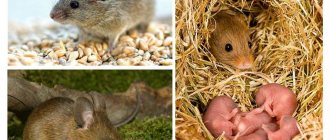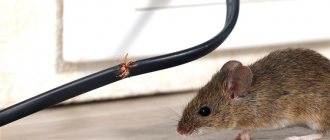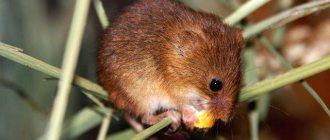In ancient times, mice were kept in monasteries and temples as sacred animals and were cultivated. A manifestation of this can be considered the fact that among many eastern peoples the first month of the calendar is named in her honor, although in some countries the mouse image was replaced with a rat one.
Some believed that these mammals could bring happiness. In Japan, there was a widespread belief that if you keep a white mouse in your home, it will rid the house of the attacks of its wild counterparts. In turn, astrologers in Ancient China used these rodents to make predictions.
But it was not only in the east that mice were cultured. Even if it was not whites, but brownies, they were revered in Ancient Greece. The image of a mouse was inextricably linked with the cult of Apollo, who was often depicted with a mouse sitting at his feet.
In some regions of Greece, Apollo was considered the patron saint of these rodents, and therefore they were kept in temples.
In other regions, he was considered a god who protected the homes of his admirers from the damage that these animals bring and from mouse invasions. There was even a myth about this.
Mass breeding of these animals began at the end of the 19th century, when the first batch of these rodents was imported to Europe for the purpose of scientific research. At the moment, they have become an indispensable resource for carrying out various experiments and the need for them does not fade over time.
Size and character
In size, snow-white mice are not very different from their relatives. They weigh from 18 to 30 grams. The body length is up to 11 centimeters, the tail length is from 5 to 11 centimeters.
They are very active, climbing all the time. In addition, they are absolutely non-aggressive and easily find a common language with their relatives and owners.
If you want to get several of these mice at once, then there is no need to worry about their behavior and buy several cages. They get along peacefully, share food and resolve issues of dominance without the use of force. But they need to be placed in a cage together and preferably at an early age. If a newcomer is added to an already existing group that has been living together for a long time, the residents will definitely begin to pursue him, especially if it is a male. Such persecution often leads to the death of a stranger.
But one individual is also of interest for its habits: it easily makes contact, trusts its owner, happily runs towards an outstretched hand, waiting for the next dose of affection or food.
Don't forget that these rodents are good parents. After the birth of the cubs, not only the mother, but also the father takes care of them; together they build a nest and take care of the offspring, surpassing almost all domestic pets in their “family” nature.
Decorative rodents
Selection has provided hundreds of different subspecies of mammals that sing and “waltz,” differing in their specific coat tone.
There are albino animals, and there are black, ash, and cream colored animals.
When choosing an animal, give preference to the following breeds of domestic mice:
- A miniature Japanese mouse, no more than 5 cm long, whose white skin is decorated with black and brown spots. Friendly and clean, she is a supporter of the nocturnal lifestyle and gives birth to up to 7 cubs.
- Spiny mice with needles on their back. It is reddish-brown or blackish-red in color. There is a hump of fat on the neck. It has an elongated nose, bulging eyes, and oval ears. The active animal loves people and becomes attached to them.
- A striped African specimen with an interesting coloration of light and dark stripes. It does not emit a smell and likes to climb on vertical surfaces. The mouse is extremely cowardly. Sensing trouble, she pretends to be lifeless or jumps up to two meters high. Does not grow longer than 10 cm.
Breeding white mice
The gestation period of a female lasts 19-21 days, at a time she gives birth to an average of 3 to 7 children, whose weight does not exceed 1.5 grams. Newborn babies are deaf, blind and bald. Already on the second day of life, the backs of rodents begin to become overgrown with light fluff, and by 8-10 days their bodies are completely covered with hair. The female feeds them with milk for 4 weeks from the moment of birth, but already a couple of hours after birth she is ready for new fertilization.
At two weeks of age, a white mouse already begins to leave the nest and, under the careful supervision of its parents, makes its first attempts to explore the world around it.
At the same age, it is recommended to gradually accustom little mice to other foods, adding small portions of food to their diet, which will alternate with milk.
At the age of one month, they are already able to take care of themselves without the help of their parents, and at the age of two or three months, they are ready to reproduce and give birth to their own babies.
These rodents live on average 2-3 years, but there are cases when their life span reached 5-7 years.
Diet composition
The white rat eats mainly grain feed. They are purchased in specialized stores and given in unlimited quantities. In addition to grain mixtures, white rats eat succulent food, which consists of salad greens, fruits and vegetables.
Additionally, protein food is introduced into the animals’ diet, which is very important for young animals, pregnant and lactating individuals. To pamper or reward pets, they are occasionally given treats such as banana chips, unsweetened popcorn, nuts and seeds.
A healthy rat diet should include:
- 60% grain mixture;
- 20% succulent feed;
- 10% protein products;
- 5% fermented milk;
- 5% treats.
Content
When it comes to keeping these pets, they are absolutely unpretentious: they do not require special food, large space, or exorbitant financial costs. There is no need to rack your brains for a long time about what a white mouse eats.
These rodents are easy to train and, having gone through the path of adaptation and getting used to the owner, they do not hesitate to go into his arms, although it is not recommended to let them out of the cage unattended: if they hide, then finding them and catching them will not be the easiest task.
Requirements for a white mouse's home:
- They need to be kept in a metal cage, preferably with pull-out trays and holes no larger than 10 centimeters, otherwise the rodent will easily slip through this hole.
- It is recommended to change the litter daily.
- The cage should not be placed near heating devices or left in a draft.
Some owners prefer to keep rodents in aquariums. This is not the best solution, because the walls easily fog up, and cleaning the aquarium is much more difficult. If you still decide to take this step, then do not forget to buy a metal mesh with small holes in the kit: this will allow air to get inside, but you will be able to avoid your pet’s attempts to escape.
If you plan to keep only one rodent or a pair, a cage measuring 30x15x20 cm will be enough for them . If you plan to have more than two mice, then it is better to immediately buy a house measuring 50x20x20 cm. This space is enough for 2-3 pairs. In the case of such a neighborhood and the presence of several females, they most often group together, make one nest for everyone and raise newborns together. Under such conditions, even if one of the females dies, the remaining ones will feed her cubs along with their own, becoming “foster mothers” for them.
What should be in the cage:
- pieces of branches and chalk, stale bread. They help grind teeth and prevent overgrowth of incisors, promote adequate mineral nutrition;
- litter For it, you can use resources such as paper, hay or sawdust. Pets will be able to build their own nest from the same materials;
- house;
- shelves;
- running wheel.
Training of decorative rats
The variety of types of games with a rat will surprise you
Decorative rats have a natural intelligence, which makes them easy to train. It has been noticed that individuals with colored fur are more capable of learning. White rats are more inert. In addition, their eyesight is worse.
Rules for training decorative rats:
- The last meal should be 10–12 hours before the start of classes. In this case, the pet will be more active in seeking the treat.
- The maximum lesson duration is 30 minutes.
- Before starting training, the animal is given the opportunity to sniff and explore the place where the lesson will take place. In this case, the rat will not be distracted by unknown odors.
- Training is carried out starting with the reinforcement of random movements and actions. If the pet jumps over any object, reward it with a treat and return it to its original position.
- They complicate the task only after the previous actions have been fully practiced and consolidated.
Tricks that decorative rats can perform:
- jump over an object;
- jumping through a hoop;
- searching for treats in the maze;
- walking on hind legs;
- taking a piece of paper out of the box;
- choosing a specific item from several located next to each other;
- running up stairs (including rope stairs).
Playing together brings pleasure to both the owner and his pet. Most popular toys:
- small balls (ideally from table tennis);
- beautiful pieces of paper;
- matchboxes filled with treats.
Watching your pet play is interesting and educational. The game reveals the character of the rat, and the owner begins to better understand his pet.
There are many tricks that complement the natural habits of rodents and will bring pleasure to the owners. To do this, you will need a treat - a piece of meat, a pumpkin seed. How to train a decorative rat:
- Return to the cage. After the animal has taken root, it can be released for a walk around the apartment. It’s easy to return the animal: at the same time you need to sprinkle food, knock the bowl on the floor and call your pet - he will come running.
- “Sit” or “serve.” You need to hold the treat over the animal’s head and say the command. The rat will learn that it gets a treat after it stands on its hind legs and will follow the order to “sit” every time, even without a treat.
- Run in circles. You can move the treat along a trajectory and give it to the animal after it completes the trick. Also, with the help of treats, it is easy to teach a rat to run up stairs.
The process of training rats is simplified due to their friendliness. Individuals can be easily tamed to climb into and out of their owner’s long sleeves. Rats love to rummage through boxes and find things there. By regularly rewarding and stroking them, rats can be taught to fetch small items or jump over obstacles. Rodents can also easily learn to climb a rope or hoop.
Of course, you should never hit your pets. Such behavior towards him will not give any results in terms of training. Among the simplest tricks that you can teach a rat is to respond to its name and come to its owner, and also to stand on its hind legs when ordered. Quite often, sunflower seeds or small pieces of fruit are used as rewards.
Moving away from the topic, I would like to talk about the origin of domestic rats. The 16th century, when rats filled all medieval cities, is a thing of the past, but it is from this moment that their domestication begins. Human breeding of rats reached its peak in the 19th century, when individuals were bred specifically to participate in battles. During the same period, albinos began to be used for laboratory research.
Of course, not all rats took part in battles or were experimental subjects; some individuals remained with people as pets. Since then, they have lived next to people, and their disposition has become more docile than that of their wild relatives.
To learn how to care for a rat, watch the following video.
What to feed a white mouse at home?
What does a white mouse eat at home? Its diet, like that of any rodent, must be balanced. A white mouse eats about 50 grams of food per day. This quantity may include the following components:
- Grains from crops such as oats, wheat, rye and rice.
- Vegetables (cabbage, carrots, lettuce).
- Cottage cheese.
- It is useful to sometimes feed them with stalks of green grass.
- Fruits such as pears and apples will also benefit them.
- Sometimes pets can be pampered with seeds.
- Legumes should be given in limited quantities.
- Pregnant females and nursing mothers should be fed vitamin supplements and fish oil.
- Animal feed should be added at least once a week. This can be any invertebrates and sometimes raw meat.
- Spicy foods, as well as fatty or fried foods, should not be given.
- It is not permissible to feed rodents candy.
When wondering what an animal eats at home, you also need to think about the dosage of food. Of course, these pets are not aggressive and share food peacefully, but it is still better that they do not lack it. For example, if we talk about animal food, then it is worth allocating three insects for each rodent. By following these simple recommendations, you won’t have to worry about what to feed your white mouse to keep your pet healthy.
Of course, you can come across a wide variety of food on the Internet, but it is worth remembering that choosing a diet without chemical additives is much safer for your pet. Therefore, we do not recommend trusting advertising pictures with the inscription “food for white mice,” even with colorful photos.
We can sum it up by saying that these animals do not require much effort to maintain their vital functions at home. You just have to arrange their home, feed them properly and change the bedding. For this, the animal will thank you with its attention and curiosity.
Treats
To pamper a white rat or reward it for a correctly performed trick, you can use different treats:
- seeds (flaxseed, sunflower, pumpkin or watermelon);
- nuts (peanuts, cashews, hazelnuts or walnuts);
- pasta;
- rice paper;
- homemade popcorn;
- biscuits;
- homemade crackers;
- unsweetened cereal (wheat or corn).
Diseases
Like all animals, mice can get sick. Basically, all diseases of ornamental mice arise from improper maintenance. For example, due to low humidity in the environment, a mouse can develop tail ring syndrome, where ring-shaped sores appear on the tail. Therefore, it is better to keep the cage where the humidity levels are 50-55%.
Mice also suffer from pneumonia, salmonellosis, which, by the way, can be transmitted to humans, mousepox, otitis media and many other diseases, and some of them, unfortunately, cannot be treated. It often happens that a mouse dies within two days during illness. Not all diseases can be seen by symptoms, but some symptoms need to be known because they are not typical for a healthy mouse, namely:
- weight loss;
- ulcers on the body;
- frequent urination;
- blood in stool;
- partial baldness.
It is important to monitor the animal’s living conditions and immediately contact a veterinarian if any of the above symptoms are detected.
Features of life
The life of a mouse The timid nature of a rodent is not at all associated with a cowardly disposition
The small animal is forced to behave carefully, since it has plenty of enemies
A mouse in the wild is trained in various skills - crawling, swimming, digging, and some species even fly. This existence allows rodents to overcome obstacles, adapt to new conditions, and get food everywhere.
The mouse makes its home in the ground, digging out complex labyrinths, in trees, in old hollows, bird nests, and under stones. Once in a person’s house, it settles down under the floor, in the attic, between the walls. Activates activity in the dark. Tries not to go too far from the nest or burrow.
Most species of mice live in packs. A whole hierarchy is built with a male leader and several dominant females. Each individual is assigned a territory where it can obtain food. The Sakis raise their offspring together, but after they “come of age” they are unanimously expelled from the family to live independently.
Mice hibernate in several places:
- in holes deep in the ground;
- haystacks in the field;
- in barns, warehouses, outbuildings, sheds, and a person’s home.
Rodents that remain in the field for the winter prepare food supplies. The hole has several chambers where the mouse carries everything that is valuable to it and will save it from starvation.
Natural enemies of mice are reptiles, wild animals, hedgehogs, large birds, dogs, cats. Since in our area the reptile is not as widespread as in warm countries, predators from this genus are snakes and some species of snakes.
In nature, a living mouse exists for only 1 year. Such a short period is associated with a large number of enemies and natural disasters. The lifespan of mice is genetically determined to be about 5 years. In artificial conditions they can live for about 3 years. In the laboratory they lived until 7.










